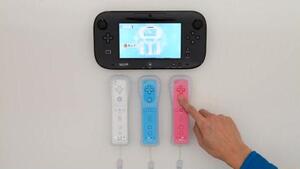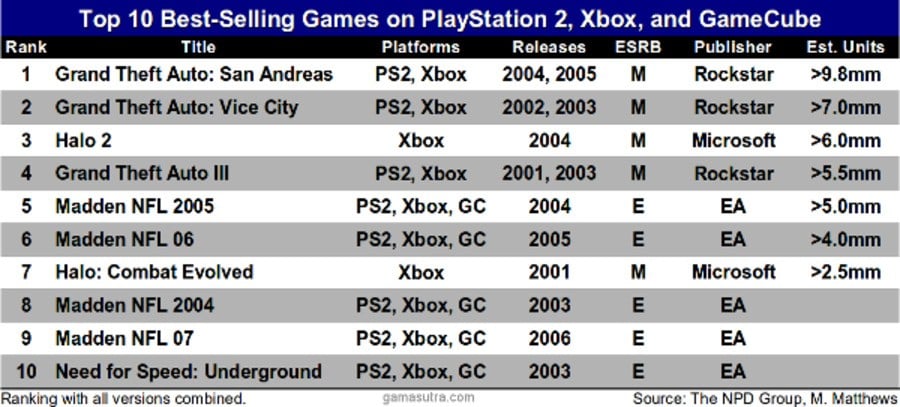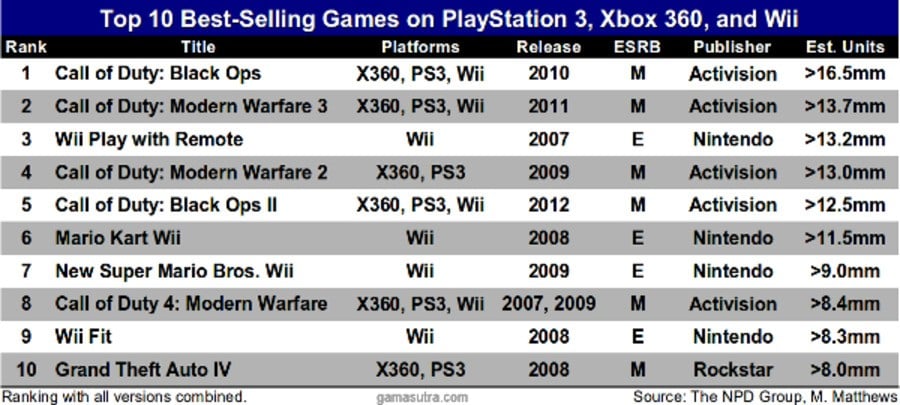
While much has been said over the years about the disruptive influence of the Wii in the video game industry, it often needs little more than raw statistics to back it up. It's also, arguably, set high standards that are exceptionally difficult for Wii U to meet; sales and impact that have proven impossible for the new system in it's first few months, which it will perhaps also struggle to hit in the medium to long term.
As has been said elsewhere, the game industry is in the middle of another disruptive, awkward period where the goal posts are moving on a regular basis. One area under strain is the retail game market, with pressures on the pricing model, high street stores and development costs. The market is evolving, but perhaps Nintendo can take heart from the fact that, in the most recent shake-up of the retail market, it fared well.
Gamasutra took on the task of looking at software sales in the U.S. over the past two generations of home consoles, with some interesting results.

This first image shows the GameCube/PS2/Xbox era, and shows a clear dominance of multi-platform games — with the exception of the Halo titles — that were either mature experiences or EA published sports/racing games. GameCube has a presence in terms of multi-platform releases, but ultimately lost that particular console war in terms of unit sales.

These results reflect the end of the current/last generation, and show a shift with headline Wii titles fighting their way into the top 10. Call of Duty dominates in the multi-platform stakes, but the Wii exclusives' presence shows how big an impact the system had on the market, with the games in question being those typically associated with attracting less experienced gamers — or casual gamers, if you fancy opening that can of worms. If Nintendo could bottle these results and reproduce them, it'd be very happy indeed.
These figures, put together with assistance from NPD, do perhaps reflect how much some things can change at the top end of the market between generations. The coming generation that includes Wii U will have a lot of new variables, such as the role of download retail games, Sony's potential movement into some game streaming services, and challenges from alternative platforms.
There's also a final statistic that can arguably put a positive gloss on recent headlines of declining retail sales. In the respective top 10 lists, the previous generation big-sellers combined to around 50 million unit sales in the U.S., while the most recent generations' top 10 is estimated to have surpassed 100 million units. Retail game sales have dropped in the past couple of years, a challenge for the big three console makers to take on, but they've dropped after what's arguably been an impressive burst of growth — at least in the case of sales of the most popular games.
What will the coming generation bring, and will we see equally impressive figures for Nintendo and the industry as a whole in five to six years? Will Wii U and its competitors gradually capture the public's imagination and secure a healthy future for "traditional" gaming hardware and business models? We'll just have to wait and see.
[source gamasutra.com]





Comments 34
Got to love that CoD is on the top of the last generations leaderboard./sarcasm
What's the best selling 8th generation game console atm? Oh right... that'd be the 3DS. And that's sold how many units vs the PS Vita? Well, the 3DS has sold about 30 million units, according to Vgchartz, and the Vita has sold about 4 million units. The 3DS, in less than 2 years, has sold more units already than the GameCube's lifetime sales.
Now, if you want to go last-gen, the DS is the best selling video game console of all time, Super Mario Galaxy is the highest rated game of all time, and the Wii was the best selling console of the last gen, selling about 100 million units, with the PS3 selling 73 million and the Xbox 360 selling 74.3 million.
Going back to current gen, here's a good example of a game that's selling REALLY great right now — and it's not even out in America and UK yet. Animal Crossing New Leaf has sold 78,000+ copies in Japan alone.
My point is, Nintendo's doing fine. There is no need to worry, I'm sure Nintendo will do fine this generation.
I think it's important to note that more recent statics indicate that NSMBWii and SMG sold 26 million and 11 million respectively. Modern Warfare 2 sold 22 million. Looks like Reggie won that bet against Activision on whether Mario would outsell Call of Duty.
@3Dash Actually, Super Mario Galaxy 1 is the top rated game of all-time, beating out Ocarina of Time.
http://mynintendonews.com/2012/11/02/super-mario-galaxy-is-now-the-highest-rated-game-ever/
And for good reason.
Durango? Codename or not, it's still better than PS4.
Edit: @SuperMinusWorld : I blame the edits made to Ocarina's later rereleases.
I don't really like to get into talks about stuff like this, but as much as I hate to say it, no matter how many copies of a game like say, the future upcomings of Mario Kart U or SSB 4 . Wouldn't it be kind of fail in comparison to say how many copies of say something like the PS4 sells. I mean, I know that Nintendo can really deliver when they want to with nice 1st party titles, but at times, 3rd party games are a completely different story.
@SuperMinusWorld Ah, ok, I thought it was SMG2, anyway, you knew what I meant.
@TwilightV .......and you have proof of this?! Right. -_-
No surprise here about Nintendo doing well. I'm one of the few that's not worried!
These are some weird times. Again, the Nintendo presentation at E3 2013 is going to have have a major influence on hardware and software sales. The unfortunate reality is that the market is shrinking and there is no way of telling what the outcome will be for any major developer.
As I said in the NL post about that Cliff from Epic Games and how "Nintendo's gonna go third-party, nyah nyah nyah", the Wii was the subject of a lot of mockery after its launch, but then... well, see the numbers.
If Nintendo plays its cards well at E3 2013, the Wii U is gonna be back on track. Believe it!
Hey what happened to Melee's numbers?! I'm sure that game sold well over a couple million for GC.
Melee sold 7.07 Million unit, idk why it isn't on that list.
I have no doubts personally on all accounts for nintendo.
@Rafie : No, i'm not even being serious.
The fact that they even included "Wii Play with Remote" as a "game" makes it hard for me to take anything they write seriously. Wii Play is basically the first iOS game. It's pure junk and not even worth the $10 it cost to go with the $40 Wiimote. Links Crossbow Training was so much better, even as limited as it was.
Somebody should show these numbers to Rockstar, maybe they'll make a new GTA game
These are US figures only, remember, not worldwide
I'll never buy another COD game again, so many other great options to us my limited gaming time on.
Jesus its just so predictable, im sick of COD i doubt we will ever see games that truly deserve to be there.
I don't think those numbers are right. I'm pretty sure NSMB sold a lot more than that.
EDIT- whoops I was thinking world wide sales which NSMB had 26.26 million sales.
COD had half the top ten US games in the last generation?!? I assume it's probably the same in the UK.
I actually find that quite an alarming industry split: COD (& GTA) vs. Wii (Play, Fit, New).
i want to see UK figures, european figures and worldwide figures
look at the latest figures on vgchartz.com ... on the latest weekly hardwhere chart Wii U in europe sold 8,709 and Wii sold 8,385 so the wii has sold more thats a good sign!
Uh... no. The Wii U should be selling MORE than Wii.
Interesting. Nintendo will be fine.
What others said, Ninty will do well, I'm sure.
Also, the fact that there's 5 CoD games on that list scares me.
First thing that bugs me about sales numbers is that why should any company expect unlimited growth forever? That's just crazy, and will never happen. So shoot for realistic goals and be happy. But don't get me started on this...
What I wanted to say is regarding "new gamers". Well I'm one. And it's because of the Wii U. I don't know if my story is common or if I'm just odd, but here it is.
Years ago I picked up a PS2, since it was a 1st gen version of the console I guess it wasn't too long after it came out. The thing is I never really got into it as it never impressed me. Maybe I never got that one game that blew me away. I had it plugged into a 64" HD TV back then. I got my first HD TV in 1999.
So with that experience when the PS3 came out and was HD I wasn't all that interested in messing with it and well no thanks Xbox. Don't get me started on M$. But somewhere along the way the Wii came to my attention and I really did want to pick it up, but it wasn't in HD like the PS3 & Xbox 360 was. So I thought Nintendo has to put out a new HD console eventually. Well, I guess I have been waiting three or four years for that Nintendo HD console. I almost broke down and got a Wii last year sometime, but just couldn't do it since it wasn't HD.
So I have a 4 year old daughter and a 2 year old son and so I thought they would enjoy a video game (and it gave me an excuse to get one) so I started looking again early last December for Christmas. And I was happy and excited to find that Nintendo had released their new HD console!! So for me it was a no brainier, that was what I wanted to get. But wait this new console had a nice secondary screen on the remote. Wow, now that's progress I thought. I had no idea what games were out for it, but I knew when I saw that second screen the possibilities would just be endless with it. Fortunately for me I ran into this new console a day or two I suppose after the deluxe set was released so that's what I got.
So I couldn't stand to wait for Christmas and I let the game console out of the box before to let the kids start playing with it. I tried to wait, but I just couldn't do it. I found the Wii U so interesting and fun. I know you hard core gamers are going to laugh, but NintendoLand has really sold me on the Wii U and my kinds absolutely love it. NintendoLand really shows off the possibilities of the game pad. We play it together every day and it's been fun to watch my daughter go from barely being able to play anything to occasionally beating me in some games in NintendoLand. Even my two year old son has learned his way around NintendoLand and likes to play with it. And my wife loves playing NintendoLand. So for us it's a fun family activity.
While I'm still not a hard core gamer and probably never will be, but who knows I might become one. I did buy a 3DS and liked it so much that I bought a 2nd one so both kids could play with it without fighting over who gets it. And I'll probably buy a third one so I have one that's all mine.
I've been really impressed with the Wii U and the 3DS and so I do not see how Nintendo doesn't have a real winner here. My only real complaint is that I would like to be able to buy software from the eshop and be able to use that purchase on any Wii U I own. And especially would like this to be the case with the 3DS. Why can I not have it on all my devices? The kids want to play what they want to play without having to trade consoles around to play a game. This keeps me from buying downloadable software.
So unless I'm the odd one here I think the Wii U will bring in lots of new people as time goes on and that the future of the Wii U is very secure. I have to wonder if the reason why sales have been lackluster at this point is because of Nintendo's marketing. I knew nothing of the Wii U until I saw it sitting on the shelf in Toy's-R-Us and I bought it that day. I've never seen an ad for it anywhere to this day. But on the other hand if I were Nintendo I think I would be waiting until a few more blockbuster games came out and then do a massive marketing blitz for it.
Do you see the problem here? Clearly I'm living in the wrong country!
@27 Japan has a great taste in games it seems.
I agree, I wish I could read in japanese, clearly America has forgotten what game are meant to be "games" instead we just want to shoot each other SMH :/
Zemus-DJ wrote:
I think the problem is that whats considered cool often takes presidence over whats considered fun. At the same time whats cool is just as subjective as whats fun, it wouldn't be much of a stretch to assume people in Japan find Monster hunter or Dragon Quest cooler than COD.
@MrWalkieTalkie I've though the same thing occasionally, at least in Japan people would understand what I'm talking about when I bring up Monster Hunter.
Haha, dam Japanese have wayyyyyyyy better taste then USA... Whats up with usa's love for shooting eachother, and japan just wana play with poketoys and hunt monsterssssss!!! . xD
I'm with you #27...
Please god I hope Australia imports more Japanese games vs the crappy merican ones.
I must be a member of this new breed of gamers, because much of the current journalistic coverage of video games is not satisfying me.
So many sites are panning brilliant fun games, while deceptive crap gets full marks if it has nice graphics.
According to VGChartz US sales totals for the following games show they should have been on the list - Wind Waker - 2.6m, Mario Sunshine - 4.01m, Smash Bros. Melee - 4.41m, MK: Double Dash - 4.12m. That chart is inaccurate and biased.
@skids102 I knew it! I knew Melee and others like Double Dash had to sell in the millions. Especially in the U.S. (where I'm from) People like myself STILL play those game to this day.
Tap here to load 34 comments
Leave A Comment
Hold on there, you need to login to post a comment...